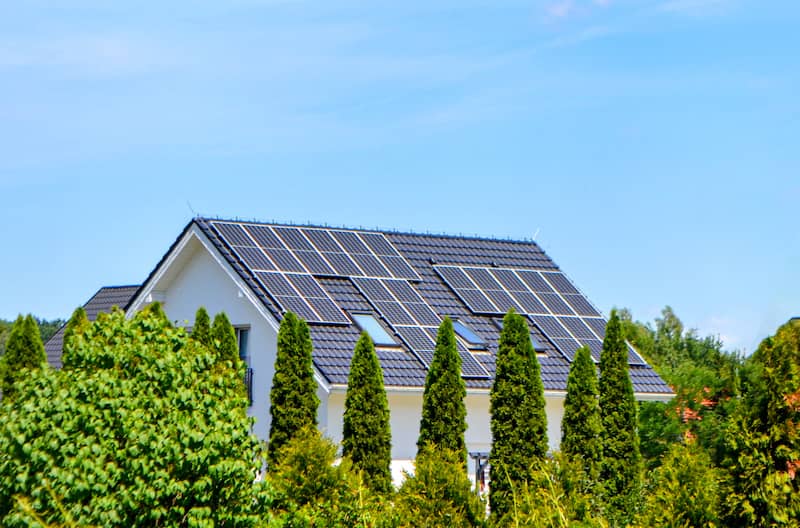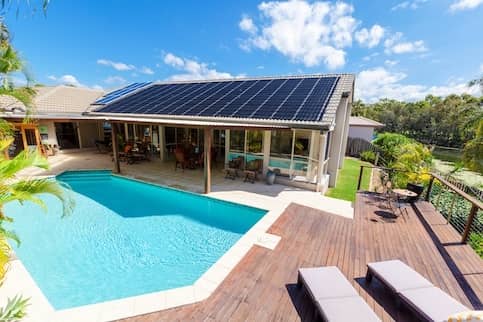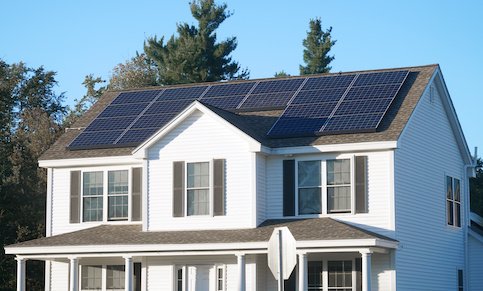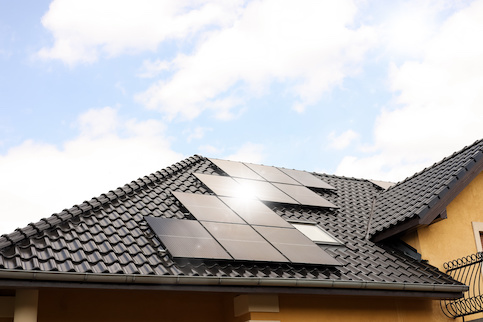Want to lower your home’s energy bills while also reducing your carbon footprint? Maybe you’d even like the added benefit of boosting the value of your home. You can do all this by powering your home with solar energy, energy produced by the sun that you can harness through solar panels.
But before you make the move to heating your home and warming its water supply through solar, you’ll have to answer one big question: “How many solar panels do I need to adequately power your home with solar energy?”
How Many Solar Panels Are Needed To Power A House?
You’ll have to consider several variables when calculating the number of solar panels you’ll need to power your home. These include your area’s weather – including how many sunny days you can expect each year – the number of watts the panels you choose can generate and the average amount of electricity your household consumes each month.
For a rough estimate of many panels you might need, consult the table below. To get a more accurate calculation, though, meet with a solar expert in your area.
Home size | Your household’s average monthly energy consumption | Estimated number of solar panels you’ll need |
|---|---|---|
1,500 square feet | 633 kWh | 14 to 17 |
2,000 square feet | 967 kWh | 19 to 25 |
2,500 square feet | 1,023 kWh | 24 to 30 |
3,000 square feet | 1,185 kWh | 27 to 30 |
Your Average Energy Consumption
The more energy your household consumes in an average month, the more solar panels you’ll need.
To calculate your household’s energy use, study your last 12 months of utility bills. Your electric bill will list in kilowatt hours the total amount of electricity you consumed during a month.
Depending on where you live, your household might consume more electricity in the summer or winter months. That’s why it’s important to add up the kilowatt hours your home consumed for a 12-month period and divide that figure by 12 to get a monthly average.
According to the U.S. Energy Information Administration, the average residential customer purchased 10,791 kilowatt hours from their utilities in 2022. That comes out to an average of 889 kilowatt hours a month.
Climate And Sunlight In Your Area
The weather where you live also plays a key factor in how many solar panels you will need. The amount of power that solar panels can generate will fluctuate depending on the amount of sunlight they receive each day. Say you have a 5-kW solar array in your home in Wisconsin. Your array will typically generate a lower amount of kilowatt hours of electricity than will a 5-kW solar array in Florida. Why? Those solar panels in Florida will receive more sunlight.
There is a way to measure how efficient a solar array is in various parts of the country. It’s called the production ratio. This ratio measures the difference between a system’s estimated energy output over time, measured in kilowatt hours, and the size of the system, measured in kilowatts.
As an example: A 10-kW system that produces 16kWh of electricity in a year has a production ratio of 1.6. You get this figure by dividing the solar array’s production — in this case, 16kWh a year — by its size — 10kW. That math — 16 divided by 10 — equals 1.6.
Solar production ratios typically range from 1.3 to 1.6 in the United States. This doesn’t mean that you shouldn’t invest in solar panels if you live in a state in which there are a greater number of cloudy days. It just means that you should plan on investing in more panels. To receive the same production from a solar array in Michigan as you would in California, you’ll typically need to install more panels on your home’s roof or in its backyard.
Size Of Roof And Solar Array
The size of your roof matters, too, when determining how many solar panels you need. If you have a smaller roof, you won’t be able to fit as many panels atop it.
SouthFace Solar & Electric, a solar supplier in Phoenix, says that homeowners who want to install a 10-kW solar panel system will typically need from 25 to 40 solar panels. SouthFace says that most solar residential panels are about 5.5 feet long and 3.5 feet wide, which equals a total of 18 square feet.
To fit 30 of these panels on your roof, you’d need about 450 square feet of usable space.
Type Of Solar Panel
The type of solar panel you choose is also important. There are many panel types available, and you’ll need to spend time researching which are the best solar panels for your home’s energy needs.
You can choose from three main types of solar panels, monocrystalline, polycrystalline and thin-film. Each of these panel types have varying levels of efficiency and price tags. What matters is how much power the panels you choose can generate.
If each individual panel can generate a greater amount of power, you’ll need fewer panels in your solar array. If you choose panels that don’t generate as much, you might need to install a greater number.
A solar panel’s wattage rating measures a panel’s expected power production under ideal sunlight and temperature conditions. Most solar panels in 2023 produce 250 to 400 watts of power, according to Solar.com. Panels that produce a higher amount of wattage are more efficient but typically cost more.
See What You Qualify For
Buy A Home
Discover mortgage options that fit your unique financial needs.

Refinance
Refinance your mortgage to have more money for what matters.
Tap Into Equity
Use your home’s equity and unlock cash to achieve your goals.
How To Calculate How Many Solar Panels You Will Need
You’ll need to know three key factors when determining how many panels to include in your solar system: the amount of energy your home consumes each month, how much sunlight your area receives and which types of solar panels you are installing.
Knowing these factors will help you choose the right solar panel and determine the total cost for the solar panels in your system.
1. Assess How Much Sunlight You Get In Your Area
First, you’ll need to determine how many peak hours of sunlight you can expect in your area on an average day. This number, of course, will vary depending on where you live. You can expect more sun exposure if you live in California than if you live in Maine.
The time matters, too. The intensity of sunlight hitting your solar panels will differ depending on whether it is 9 a.m., noon or 4 p.m.
A peak solar hour occurs when the intensity of sunlight reaches 1,000 watts of energy per square meter. That sounds complicated, but here’s a good rule of thumb: Peak solar hours for most of the United States happen from 3 – 6 hours a day.
To start the process of calculating how many solar panels your home will need, first determine the number of peak solar hours your property will receive in an average month. To do this, multiply your peak daily solar hours – we’ll use 4.6 hours for our example – by 30, the average number of days in a month.
That equation of 4.6 times 30 gives us 138 peak solar hours in an average month in our example.
2. Determine Your Average Energy Requirements
Next, you need to determine how many kilowatts of power your system needs to provide in a month. To do this, take the estimated annual kilowatt hours needed for your home and divide that number by 12. Your electric provider can tell you how many kilowatt hours your home consumes in an average year. For our example, though, we’ll say that your home uses 10,715 kWh in a typical year.
Divide 10,715 kWh by 12 to get 893 kWh, the monthly kilowatt hours your home typically consumes.
Now you need to determine how many watts of power your solar system needs. To do this, divide your household’s monthly kilowatt hours needed by the number of peak solar hours your area receives in a month.
In our example, this comes out to 893 kWh divided by 138 hours, which equals 6.47 kW. This means that you’ll need a solar system that provides 6.47 kilowatts. You’ll want to convert that to watts, though. To do that, multiply 6.47 by 1,000, which gives you 6,470 watts, the amount of wattage your system will need to provide.
3. Choose Your Solar Panels And Calculate How Many You Need
For our example, let’s say you pick a higher-efficiency, monocrystalline, 340-watt solar panel for your home’s array. To determine how many of these panels that you need, divide your system’s total wattage by the wattage in one solar panel.
For our example, we’ll divide our system’s total wattage of 6,470 watts by 340 watts, the wattage provided by a single panel. That gives us a total of 19.02.
This means that you’ll need either 19 or 20 panels to provide enough solar to power your home. To be on the safe side, you should round up, going from 19.02 in this case to 20 solar panels.
Solar Panel FAQs
It’s not unusual to have questions about powering your home with solar panels. Here are answers to some of the most common.
Can a house run on solar power alone?
Yes, a house can run completely on solar power. Whether you can in your home depends on how much energy your solar panels produce and how much energy your household consumes in an average month. Most solar panels today produce 250 – 400 watts of power. If you install enough panels, you could power your home entirely by solar. And if you work with a contractor to install a high-end solar system, you might even be able to go off-grid, disconnecting from your area’s public power utility. Just be careful: Going off-grid can be expensive. Many homeowners who have solar arrays that can completely power their homes still remain connected to their local energy provider as a back-up.
Do I still have an electricity bill with solar panels?
If your home is connected to the public power grid, you’ll probably receive an electric bill even if you’ve installed solar panels. Most utility companies charge a monthly fee to all residences connected to the grid, even if they are relying heavily on alternative energy sources. You’ll also receive an electric bill if your solar panels don’t provide enough power to cover all the electricity your household consumes each month. But with solar panels, your electric bill should be lower than it would be if you were relying entirely on electricity from your local utility.
Are there disadvantages to powering a home with solar panels?
It’s important to also consider the negatives of these systems if you’re debating whether you should get solar panels. These disadvantages include the high initial cost of solar systems and their dependence on the weather. If your area does not receive much sunlight, your solar array might not produce as much power. You’ll also need enough roof space for your panels. If you need many panels, your roof might not be able to accommodate them. You can install solar panels in the land surrounding your home, but this can be an eyesore and you might not have enough land for the panels that you need.
The Bottom Line: How Many Solar Panels You Need Depends On Many Factors
It’s not easy to calculate the number of solar panels you’ll need to power your home. You just need to know your area’s weather, the size of your home and the amount of power your household consumes in an average month. If you’re ready to make the leap to solar, you can dramatically reduce your energy bills. Why not get started by using our learning center to research the best solar panels for your home?
Need extra cash for home improvement?
Use your home equity for cash-out refinance.

Dan Rafter
Dan Rafter has been writing about personal finance for more than 15 years. He's written for publications such as The Washington Post, Chicago Tribune and Wise Bread.












